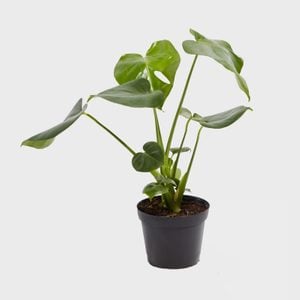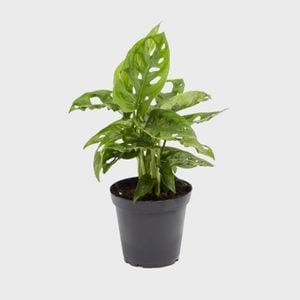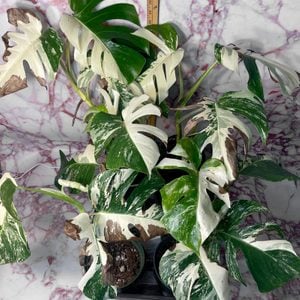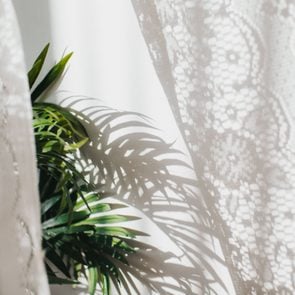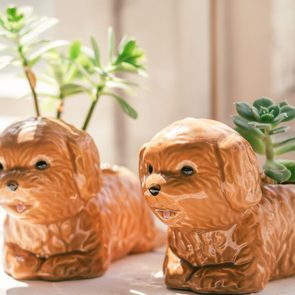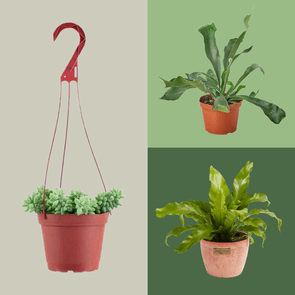How to Care for Monstera Plants
Updated: Mar. 20, 2024

These iconic split-leaf plants are a classic for a reason
Looking to add a little green to your home? Monstera plants are a great option, since they’re eye-catching and low-maintenance indoor plants. You’ll recognize them by their large, fleshy heart-shaped leaves and their standout feature, the split in their leaves. You’ve also probably heard of them by their popular names—the Swiss cheese plant, split-leaf philodendron or the fruit salad plant. Lois Whyde, a horticulturist with the University of California Riverside Botanic Gardens, points out that monstera’s huge leaves make them unique and interesting as indoor plants. There are dozens of species of monstera plants, but only a handful of them are available at your local plant nursery.
This “flowering plant” species is native to the tropical forests of southern Mexico, going as far south as Panama. Monstera plants have been introduced to other tropical areas as well, so you could see them while hiking or sightseeing in Hawaii. While they grow best in their natural outdoor habitat, where some can get up to 30 to 70 feet tall, they also do well indoors—though they won’t get as big living in your home! In general, these aren’t small indoor plants, but growing them indoors will make them fit into your space, says Whyde. Commonly pruned to around 3 to 5 feet tall, these plants can grow to 10 to 15 feet indoors, with proper monstera plant care.
In their natural habitat, they will produce creamy white flowers that look like a protective cape, growing up to 12 inches long. Inside the flower is a cone-like spike made of small blooms that will eventually turn into berries. You can cross your fingers, but monsteras rarely flower or produce fruit when cared for as indoor houseplants.
Too busy to get to your local plant nursery but want to get started with a monstera? Check out these easy options to buy plants online. In the meantime, here’s how to care for monstera.
| Botanical name | Monstera deliciosa |
| Height | Up to 10 to 15 feet indoors (commonly pruned to 3 to 5 feet) |
| Monstera light needs | Bright indirect light |
| Soil type | Loose, rich soil with good drainage |
| Soil pH | 5 to 7 (slightly acidic) |
| Toxic to pets | Yes |
Where to put a monstera plant?
These plants are easy to care for, but you need to put them in the right spot with the proper indoor plant lighting in your office or home for them to thrive. According to Whyde, monstera plants need to be in a location that gets bright indirect light. Putting your monstera plant near a window that gets full but indirect sun for most of the day works best. A covered patio works too—especially since these plants are natural climbers—as long as it doesn’t get too cold. “They naturally grow up trees, where they are covered by the tree canopy,” Whyde adds.
As tropical plants, they prefer higher humidity and temperatures between 60 and 80 degrees. Just be aware that these plants can be mildly toxic to humans, so wear gloves when pruning if you have sensitive skin. Monstera plants are also one of the plants poisonous to dogs and cats. In pets, they generally cause a skin irritation but sometimes worse, like swelling of the mouth, tongue and lips. More severe cases include vomiting and difficulty swallowing, so keep your furry friends away from this one. The best monstera plant care (and pet care!) is to keep the plant somewhere with adequate light where pets can’t reach and won’t be tempted to nibble.
Monstera plant care
Soil needs
The best soil for monstera plants is loose, rich soil with good drainage. Peat moss is a good option for monstera plants, since it allows for quick-flowing drainage while holding in some of the moisture. You need to make sure your pot has adequate drainage holes at the bottom so the soil doesn’t get too soggy. Your goal should be to keep the soil moderately moist, but don’t let your plant sit in a tray of soaking water. Soil that is too wet can lead to fungus gnats or white fungus balls on your plant.
Watering needs
The basic rule of thumb for monstera watering is to water this plant when it feels dry. You can feel the soil with your finger to estimate when the top half feels dry. If the leaves are drooping and curling, you’ve waited too long. An easy guide is once every week during spring and summer months, possibly every other week depending on your home’s growing conditions. Plant watering tip: How often to water monstera can vary by season, as the houseplant requires less water during fall and winter months. Water until you see liquid exiting through the drainage holes, then make sure to let it drain completely before putting it back on its tray.
Fertilizer needs
The main issue for monstera plants is finding a fertilizer that’s high in nitrogen, according to Whyde. Phosphorus and potassium are additional macronutrients that contribute to healthy leaves, stems and roots. In general, a slow-release granule works well, since it will keep your plant nourished over a longer period of time. You’ll be glad you took the time to focus on good monstera plant care, which will boost your plant’s growth, color and foliage.
A few popular varieties
These are some of the most popular types of monstera:
Common pests
Spider mites are the most common houseplant pest for monstera plants. You’ll notice little white spots initially, then the leaves will turn yellow and eventually brown, due to the plant’s loss of chlorophyll. If the white spots aren’t obvious, you can look for their nearby web to confirm your suspicion. A quick option for getting rid of spider mites is spraying them with insecticidal soaps or oils formulated to kill pests. Neem oil is our favorite natural option, which is safe for humans and pets.
Aphids can be a problem on newer growth, but generally they aren’t able to penetrate more mature leaves. You may find scale on the stems or leaves, which are tiny beige or brown insects. You’ll likely be able to see some of the pests, according to Whyde, who says the plant will start declining. Ladybugs are a great natural option for getting rid of unwanted pests, or you can purchase a variety of sprays from your local plant nursery. As with all plants, it’s good monstera plant care to be careful bringing in plants from outside that may introduce bugs to your other indoor plants.
How to propagate a monstera plant?
Learning how to propagate monstera is pretty straightforward and simple. You have a few basic options, according to Whyde, who shares, “The easiest way is air layering.” The plants naturally root where they touch the soil. Once they’re rooted, you can cut that portion off with its roots using clippers. If that’s not your preference, you can go in a different direction: “You can also take stem cuttings; then lay the piece, which must include a node, onto the soil,” she adds. The node is the small lump where a leaf was previously growing.
Signs it’s time to repot a monstera plant
You’ll start to see some obvious signs when it’s time to repot your plant. This partly depends on how big you want it to get as an indoor houseplant. It might sound obvious, but if your plant starts to look too large for its pot, then it’s time to repot it. Another clear sign for when to repot monstera is the presence of lots of aerial roots. You might not think repotting is necessary, but houseplants in pots don’t get very much soil, so giving them a fresh pot with new soil is necessary for additional nutrients that break down over time.
Just make sure to clean and prune your monstera plant back before you transplant it—and don’t be afraid of giving this one a good trim, since it’s pretty indestructible (trust us). The lower, older leaves will naturally turn yellow and die, so this is a good time to pull those off for a fresh start. Cutting back monstera leaves that are turning yellow and giving the plant a good trim allow for new growth and are a natural part of monstera plant care. It can even revive a dead or dying plant! To continue to add to your garden, check out these air-purifying plants and medicinal herbs you can grow.
Source:
- Lois Whyde, horticulturist and plant nursery technician with the University of California Riverside Botanic Gardens





















